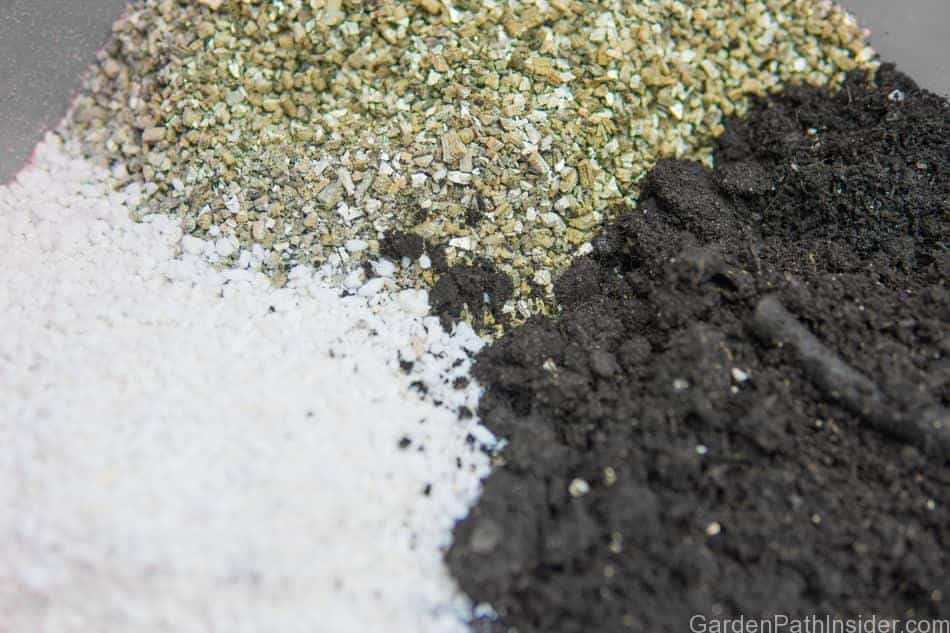
There are many growing mediums used in gardening and horticulture. In this article, we review the top four soil amendments and compare the pros and cons of each.
Perlite, Vermiculite, Peat Moss, and Pumice are all soil amendments used in many applications of horticulture; from soil aeration, improved water retention, and used as a substrate to sprout plants. Each amendment has its advantages and disadvantages. This article provides a detailed comparison.
The article below is arranged with definitions of each substrate presented first, followed by comparisons between each substrate. We have compared each soil amendment against each other and provided recommendations to the best application for all Perlite, Vermiculite, Peat Moss, and Pumice.
Cover photo: Perlite, Vermiculite, and Organic Soil © cendeced/123rf.com
Perlite Explained
What Is Perlite Made Of?
Perlite is frequently used in gardening, though it is used in applications from construction to cosmetics.
Perlite is volcanic obsidian glass with a high water content that is processed into a Styrofoam textured material used in gardening and other commercial uses. The obsidian ore is rapidly heated to temperatures of 1800°F (980°C) and expands up to 20 times its original size into sturdy foam pieces.
Perlite is the commercial name for a volcanic siliceous glass, a non-crystalline (amorphous) mineral solid. Perlite begins as volcanic obsidian with very high water content. Once the mineral is mined from the earth, it is processed in factories where the glass is rapidly heated up to 1800°F (980°C) forcing the mineral to expand up to 20 times its original size. Source: US National Library of Medicine, National Institutes of Health
After the ore is expanded it changes to a soft foamy texture that is light and porous, while still sturdy enough to keep soil from densely compacting its foamy texture. These characteristics make perlite a great addition to potting mix and garden beds.
Perlites’ properties allow soil to remain loose without compacting. The porous structure of perlite absorbs excess water from the soil, retaining the water and slowly releasing it over time. Sitting water on a plants’ root ball can quickly kill the plant.
Perlite deposits are found in five US States, Arizona, Idaho, Nevada, and Oregon, according to the U.S. Geological Survey, Mineral Commodity Summaries.
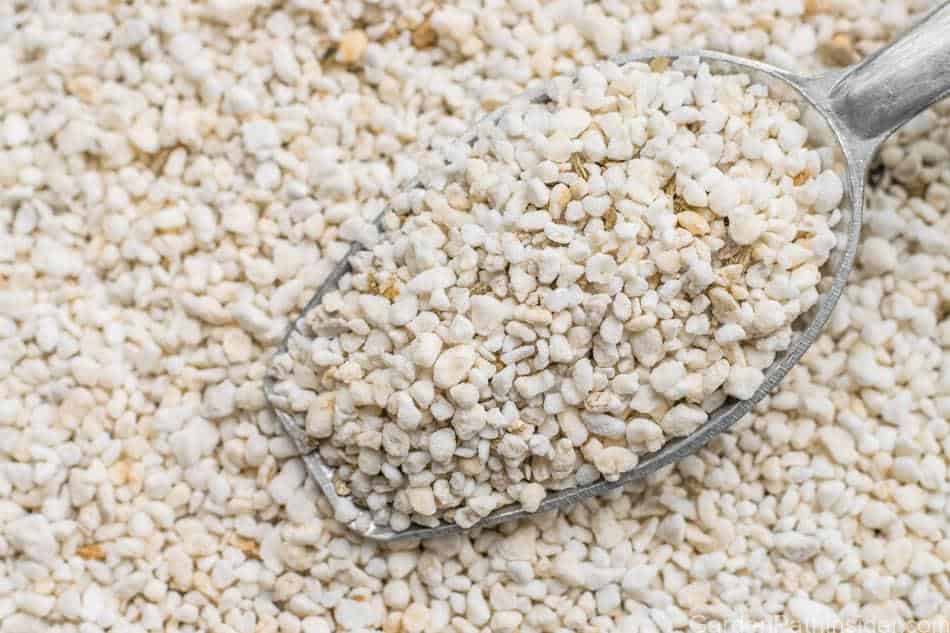
What Is Perlite Used For?
Perlite has many applications in our day-to-day life, though perlite is most popular due to its use in gardening.
Perlite is used in horticulture to provide aeration and moisture retention to soil while preventing the soil from becoming too compact. The US consumes roughly 610,000 tons of perlite annually with only 16 % used for horticulture, with the majority (53%) used in construction applications, site USGS.
Perlite is used in horticulture as it is relatively inexpensive and does not compact or degrades when reused repeatedly.
The physical characteristics of perlites’ structure and texture, along with its cost, allow it to be used in many applications. 53% of perlite produced annually is used in construction products, 16% is used in fillers, 16% is used for horticulture, and 15% is used as filter aids/other, according to the U.S. Geological Survey, Mineral Commodity Summaries.
Perlite in horticulture is blended with soil or used on its own as a growing medium. Perlite is used for water retention and aeration in growing conditions. Expanded perlite will absorb and retain water for extended periods of time.
When perlite is mixed in soil, it keeps moisture in the soil without keeping water standing on the plant’s roots. The added water retention helps thirsty plants like mint, basil, tomatoes, and even wild mushrooms, survive through periods of drought.
Related article: Growing Wild Mushrooms – From Liquid Cultures, Spores, or Plugs
Perlite is a great substrate for growing your own culinary mushrooms. The trend in home-growing culinary wild mushrooms is a great way to cook with mushrooms that may be seasonal if collected through forest foraging.
For more information read our article: Growing Wild Mushrooms – From Liquid Cultures, Spores, or Plugs
When plants are grown or rooted in only perlite, the perlite will provide water retention along with providing the plants’ roots with strong anchor points for stability and strength. Hydroponic growers frequently used perlite as a growing medium.
Perlite also provides aeration when mixed in soil. The strong yet absorbent texture of perlite prevents the soil from compacting and becoming too dense for roots to grow through. Perlite can be reused and will not deteriorate or compact from repeat uses.
The construction industry uses perlite in many applications as it is fire resistant, lightweight, and can be a great insulator.
The cosmetic industry uses perlite as an absorbent exfoliant.
What Is Perlite Soil?
Perlite soil is potting soil premixed with perlite. Perlite is added to soil to aid moisture retention and soil aeration. Perlite soil is a great choice when growing a small container garden. When growing a large garden, perlite can be purchased separately and added to topsoil in garden beds.
Perlite soil can be bought premixed, or perlite can be purchased individually and mixed with soil already in your garden.
The benefit of buying premixed perlite soil is the premixed soil may also have other “slow-release” fertilizers or nutrition mixed in for plants.
If you buy perlite to make your own perlite soil, consider also purchasing an organic fertilizer to mix into your soil. Mixing all ingredients into the soil at the beginning will ensure a well-blended growing medium for your garden.
What Is Perlite for Plants?
Perlite for plants is the same soft foamy perlite used in many commercial applications. Perlite for plants is sold by grades based on grain size. Grades range from coarse to fine. Expanded perlite is then mixed with soil, used solo as a growing medium for rooting plants, or used for hydroponics.
All commercial perlite begins as volcanic siliceous glass. The volcanic glass is mined and processed into commercial-grade perlite by rapidly heating the ore to temperatures of 1800°F (980°C). When the ore is rapidly heated, it expands up to 20 times its original size and changes from a solid rock texture to a foamy light texture. According to the National Institute of Health.
Once the perlite has expanded it is used in several horticulture applications.
The expanded perlite is mixed into the soil and allows the soil to retain moisture without the soil itself holding the excess water. Perlite then releases moisture back into the soil as needed. Additionally, perlite aerates the soil and prevents the soil from becoming too compact and hindering root development.
Perlite is used for many applications from horticulture to cosmetics.
Perlite for plants is sold in several grades that vary by the size of the grain of perlite. The grades range from course grade to fine grade.
The different sizes of perlite each have benefits. The largest grades are best when used in a large pot or garden beds. The smallest grades of perlite are best used in small pots or container gardens.
Perlite Substitute
Perlite is the preferred soil amendment in horticulture, though there are several materials that can be used as substitutes based on availability or cost. Vermiculite, wood pulp, and pumice are three of the top perlite substitutes used for their moisture retention and soil aeration properties.
Further down in this article we outline the pros and cons of perlite vs. several substitutes. Most garden stores will carry all these varieties, and each will provide different benefits depending on the type of plants you are growing. Source: pubs.usgs.gov
How Much Perlite to Add to Soil?
When adding perlite to soil, add 1 part perlite to 3 parts soil to make your own perlite soil. Add the soil and perlite into a large bucket and mix thoroughly before adding the soil blend into your growing container. Break up any large clumps of soil to allow the perlite to fully aerate the soil.
The best mixture ratio I’ve found for perlite soil is one part perlite to three parts soil. These ratios allow the perlite to evenly mix with the soil without overwhelming the soil with perlite filler.
Adding more or less perlite will not harm the plant. Perlite is used to help the soil maintain moisture and aerate soil. Too much perlite in the soil acts as a filler and means the potted plant’s roots are missing out on nutrients from the soil. More perlite means less soil and less soil means fewer nutrients.
However. some gardeners use only perlite when they are growing hydroponically. Hydroponic systems have water with nutrients for the plants, so the plants are still getting their full nutrients.
Adding too little perlite could mean the soil will hold excess water that could drown the plant’s root ball, and the soil could also become very dense without enough perlite.
Vermiculite Explained
What Is Vermiculite Made Of?
Vermiculite is a hydrated silicate mineral, a mineral with naturally high moisture content. Once vermiculite ore is mined, it is rapidly heated to extreme temperatures causing the hydrated silicate to expand and change texture from solid rock to a soft clay-like texture that is absorbent.
Vermiculite in its exfoliated (expanded) state takes on properties similar to clay. The vermiculite can absorb water and moisture for long periods of time while maintaining its strong structure. These traits make vermiculite an excellent material for many commercial applications.
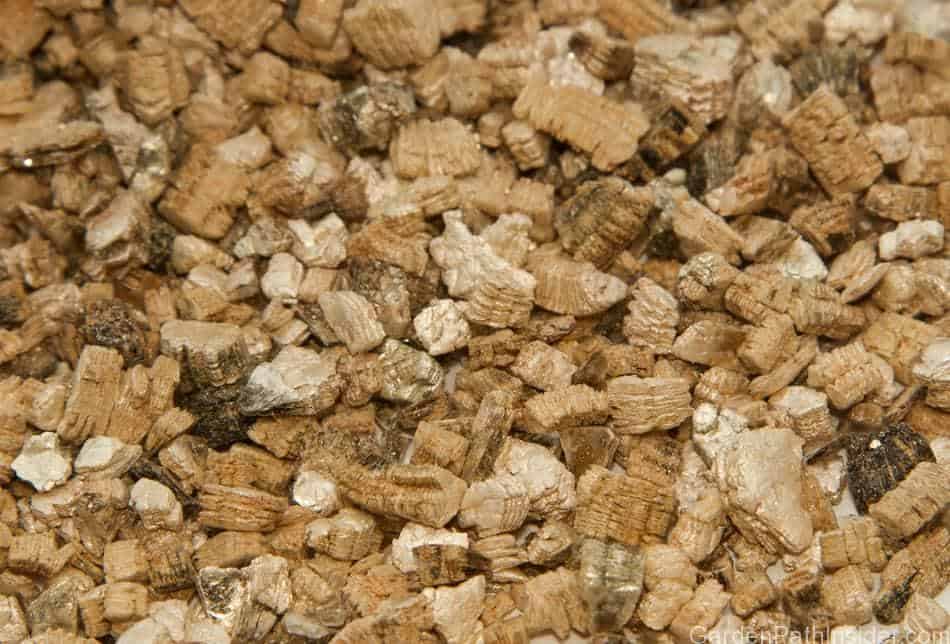
What Is Vermiculite Used For?
Vermiculite is a versatile material once it has been processed into exfoliated vermiculite.
Vermiculite is used in many commercial applications from horticulture to construction. Exfoliated vermiculite is used in gardening by mixing vermiculite with soil to aerate the soil, while also aiding in moisture retention. Vermiculite is also used in construction for insulation and fireproofing.
Vermiculite can be used in gardening by mixing vermiculite with soil to help aerate the soil and help the soil maintain moisture.
Vermiculite is great for sandy soils, or when used as a growing substrate to root plants. The clay-like material gives clippings a great base and ample moisture to begin developing roots.
When mixing vermiculite into soil we have found the ratio of one part vermiculite with two parts soil to work well with a wide variety of herb and vegetable plants.
Vermiculite is also used in horticulture as a substrate for growing fungus, or other soilless plants or mycelium. Hydroponics growers also frequently use vermiculite.
In construction, vermiculite is used in insulations in masonry, commercial thermal applications, and used as fireproofing material.
Up until the 1990s, some vermiculite products contained asbestos. The issue was identified as that the mines themselves were contaminated with asbestos. Vermiculite does not naturally contain asbestos. Today the mines and the excavated vermiculite ore are constantly tested for asbestos.
Peat Moss Explained
What Is Peat Moss Made Of?
Peat moss is the common name for the genus of Sphagnum moss. Though the term is also used to refer to a commercially available soil amendment.
Peat moss is the dead decayed remains of sphagnum moss. Sphagnum moss grows in wetland areas known as bogs, or peat bogs. When sphagnum moss dies, it slowly decays in the low oxygen environment and becomes peat. Layers of dead sphagnum moss compound, and the peat bogs become several meters deep.
Sphagnum moss is a genus containing roughly 380 species of mosses, that thrive in peatlands or peat bogs.

Sphagnum moss plant cells can hold a significant amount of water for extended periods of time. Both living and dead sphagnum moss cells can hold up to 26 times more water than their dry weight. According to the Global Biodiversity Information Facility.
When the sphagnum moss dies, the dead moss still holds significant water. As the layers of wet dead moss begin to decompose, they create an anaerobic environment. In this low oxygen environment, the dead sphagnum moss decays very slowly over many years.
The lack of oxygen slows the rate of decomposition of the organic matter, leaving behind a biomass of bogs or mires that turn into thriving peatlands for moss.
Peat is formed as each cycle of new sphagnum moss grows over the dead layer of sphagnum moss. Over thousands of years the layers of dead moss compound, though never fully decomposing. As mentioned above, the dead moss cells can still hold up to 26 times their dry weight in water, making areas of peat bogs dangerously unstable.
Peat is a perpetually wet soil that is made of slowly decaying organic matter like grasses, mosses, and other organic matter. Peat lacks significant oxygen, resulting in a very slow decay of the organic matter in the soil.
These wet conditions and slow decomposition properties prevent the peat from compacting into dense solid soil. The result is a ground not suitable for building on, due to its weak foundational properties.
Due to Sphagnum moss’s water retention capabilities, sphagnum moss contributes to the formation of peat in many ways. Sphagnum moss can store water in its cells as described above, this stored water allows the moss to grow onto dry areas of land.
The moss grows from its wetlands area and slowly grows over dry land. Over time the high moisture of the moss begins to manipulate the dry land and turn it into a wetter soil environment. The moss acts as a garden hose, bringing water from the wetlands to the dry land and eventually flooding the dry area.
Over thousands of years, the moss slowly turns the soil into an anaerobic* environment of a dense mass of slowly decaying plant matter. *Anaerobic: The absence of free oxygen. Merriam-webster.com*
What Is Peat Moss Used For?
Peat moss is used in gardening as a soil amendment to help soil retain moisture. Decayed sphagnum moss that is in peat, naturally holds up to 26 times its dry weight in water. Peat moss is mixed into dry or sandy soils and peat will naturally store water and nutrients for plants in dry conditions.
There is an important point to clarify when discussing peat moss. The terms “peat moss” and “peat” are sometimes used interchangeably in gardening and horticultural applications. However, there are important distinctions between the two terms.
Peat moss is a common name for sphagnum moss. Sphagnum moss grows in peat bogs and eventually the sphagnum moss dies and turns into peat.
Peat is a soil-like compound made of dead and decaying sphagnum moss. Sphagnum moss grows on top of peat. When the sphagnum moss dies, it becomes another layer in the peat soil compound. We cover this in more detail in the section above titled “What Is Peat Moss Made Of?”.
Peat moss is used in gardening because of the water-retaining capabilities the peat receives from sphagnum moss.
Sphagnum moss plant cells can hold a significant amount of water for extended periods of time. Both living and dead sphagnum moss cells can hold up to 26 times more water than their dry weight. According to the Global Biodiversity Information Facility.
In gardening, peat moss is used as a soil amendment and is mixed in dry sandy soils to aid in moisture retention. In addition to moisture retention, peat moss can add support and strength to the soil to give the plant roots a stable base. This is especially true in sandy soils.
Peat moss can also be mixed in nutrient-rich potting soil for plants that require moist soil, like mint and basil.
Sphagnum moss is also used in gardening and horticulture applications. Dried sphagnum moss is used as packaging when shipping seeds, bulbs, or grown plants.
Sphagnum moss used as a packaging material will absorb any moisture that is present and reduce the instance of mold or mildew forming on the seeds, or bulbs.
Pumice Explained
What Is Pumice Made Of?
Pumice is formed when highly pressurized rock is rapidly heated and forcefully ejected from a volcano or lava phisher. The rock is rapidly heated and quickly expands, creating small gas bubbles to form. The rock then rapidly cools creating a light foamy appearance, with light structural integrity.
Pumice is a volcanic rock composed of igneous rock high in silica or felsic, that is highly porous and floats on water.
The formation from highly dense igneous rock to pumice begins underground. When the dense rock is exposed to lava or magma, the rock is rapidly heated. When the rock explodes and is extruded through the earth’s crust, it begins rapidly cooling.
The cooling is even more rapid if the extrusion takes place underwater. As the rock rapidly cools, small bubbles of gas form in the rock causing the cooled rock to retain a very porous texture in its final stage as pumice. Pumice rock is extremely light and can float, even in large chunks.
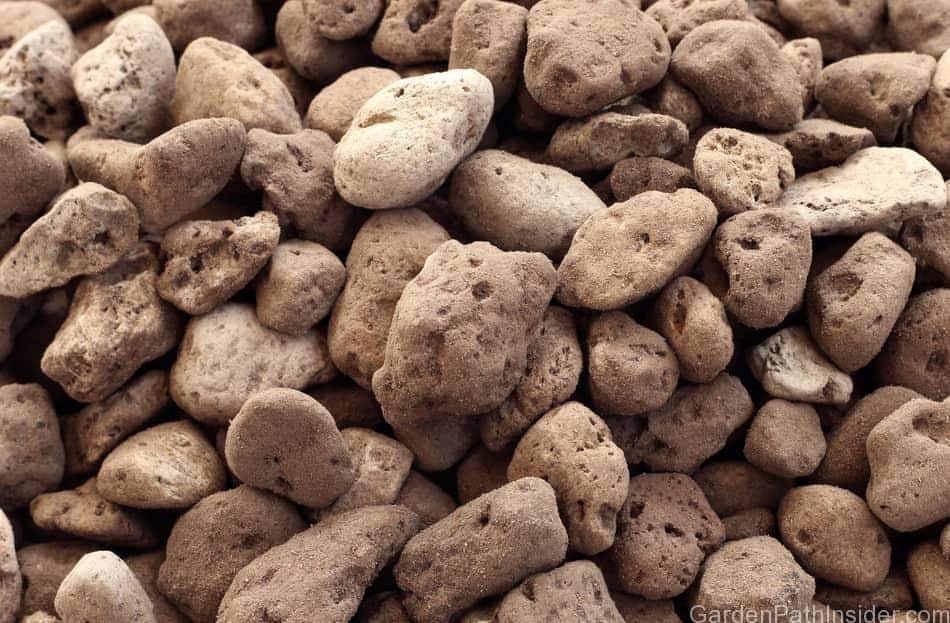
What Is Pumice Used For?
Pumice is used in horticulture, construction, and beauty products. Gardeners mix pumice into soil for improved moisture retention and soil aeration. In construction, pumice is used as insulation and mixed with concrete to form light and strong concrete. Pumice is an exfoliant in beauty products.
Pumice is used in many applications in our everyday lives, from personal care to construction, and even some surprising uses.
Pumice rock and pumicite (ground pumice) are lightweight, porous volcanic rocks that have absorptive and insulative properties. Pumice is used in horticulture, personal care and beauty care products, construction, filtration, and even in the fashion industry.
Horticultural applications for pumice include use as a soil amendment for moisture retention and aeration of the soil. The porous texture of pumice gives the volcanic rock the ability to retain water, improving soil moisture retention.
Additionally, pumices’ strong structure aerates the soil, allowing excess water to thoroughly drain from the plant’s root system.
Construction applications of pumice include use as concrete admixtures and aggregates according to U.S. Geological Survey, Mineral Commodity Summaries
Pumice and ground-up pumice, known as pumicite, are strong and lightweight and mixed into concrete to provide structural support. The strong lightweight concrete is often used in European construction designs for large dome-shaped ceilings.
Health and beauty applications of pumice and pumicite include use as an exfoliant. Large pumice rocks are often sold in brick shapes that are designed to remove dry skin and calluses from an individual’s feet and or hands. Some cosmetic products also use pumice as an exfoliant in different grades for different areas of the body.
The fashion industry uses pumice in the process of creating stone-washed denim jeans. The pumice rocks rubbing against the denim material create a distressed look that is desirable in some styles of denim jeans.
Where Is Pumice Found?
Pumice is found on all continents, as it is a volcanic glass formed by lava and magma. However, commercial pumice is mined in roughly 18 countries, with Turkey then Greece mining more pumice than any other country. In the United States, pumice is found in the Western States and the Great Plains.
Pumice rock is found on all continents and harvested for commercial use by roughly 18 countries. Countries outside of the United States use pumice and pumicite in construction applications and building materials.
The United States has identified an estimated 25 million tons of pumice resources in sites in the Western States and the Great Plains. According to U.S. Geological Survey, Mineral Commodity Summaries.
Pumice mining is less devastating to the environment than most mining methods, as domestic US pumice is collected through open-pit mining.
Pumice forms in small, isolated pieces and does not need to be dynamited or broken up before mining. Once the earth is cleared over the top of the pumice mine, the pumice can be collected with bulldozer buckets or crane scoops.
Perlite vs Vermiculite
Perlite vs Vermiculite
Perlite and Vermiculite are two of the most popular soil amendments used in gardening. However, it can often be confusing when and where to use either one.
Perlite and vermiculite are both soil amendments added to soils for increased moisture retention, and to improve soil aeration. The key difference is vermiculite has a clay-like texture that holds moisture longer and provides a stronger foundation than perlite for plants grown in sandy soils.

Are Vermiculite and Perlite the Same?
Vermiculite and perlite are not the same material. Vermiculite is a hydrate mineral with high moisture content. Perlite is a volcanic rock with high moisture content. Both raw perlite and vermiculite are processed by rapidly heating the ore until it expands and changes texture.
Can I Use Vermiculite Instead of Perlite?
Vermiculite can be used instead of perlite for gardening. Vermiculite, like perlite, is used to aerate soil and prevent soil compaction. Vermiculite, like perlite, is used to retain moisture in the soil. However, vermiculite is denser with a clay texture that retains water longer than perlite.
Perlite or Vermiculite for Vegetables?
Both perlite and vermiculite can be used for vegetables. Most ready-mixed potting soils include perlite in the soil blend. Perlite is lighter than vermiculite and may allow small vegetable roots to more easily spread through the soil.
Vermiculite vs Perlite for Succulents?
Vermiculite and perlite can both be used as soil amendments for succulents. When growing succulents soilless, Vermiculite is the recommended substrate. Vermiculite will provide better moisture retention and stronger anchor points for the plant’s root system.
Perlite vs Vermiculite for Rooting?
Plants can be rooted in perlite or vermiculite, and both materials are often used in hydroponic growing. Perlite is lighter than vermiculite and maybe a better choice, as the lighter density allows the fragile new sprout-ling root systems to spread thoroughly.
Perlite or Vermiculite for Tomatoes?
Perlite and vermiculite can both be used when growing tomatoes. Tomatoes require a lot of water and moist soil conditions. Both vermiculite and perlite substrates retain water and aerate soil. Perlite is often less expensive than vermiculite and can be used repeatedly without breaking down.
Should I Use Both Perlite and Vermiculite?
Perlite and vermiculite can be used together or separately when blending with soil or using either substrate as a solo growing medium. Both substrates will retain water, aerate the soil, and provide secure anchor points in the soil for young growing roots.
Perlite vs Peat Moss
Perlite vs Peat Moss
Perlite and peat moss are both soil amendments used in horticulture to improve soil moisture retention. Perlite has a stronger structure than peat moss. The strong structure allows perlite to aerate soil, by preventing the soil from densely compacting. Peat moss adds to the density of soil.
Perlite has a lightweight and foamy texture, though its foamy structure is still strong. Perlite is porous and can store water, these abilities make perlite great for fruit and vegetable gardens. Perlites’ structure allows the soil to aerate and for the small roots to expand through the soil.
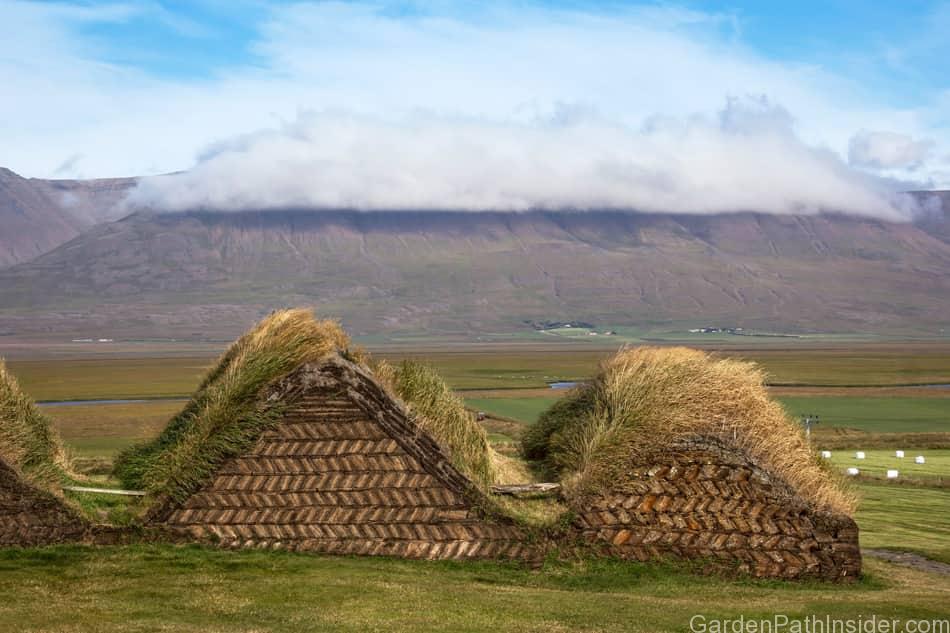
Peat moss looks similar to mulch and is much denser than perlite. Peatmoss is a great addition to dry sandy soils that lack strong substantive anchor points for larger plants roots to latch onto for structural support.
What Is the Difference Between Perlite and Peat Moss?
Perlite and peat moss are different substrates. Perlite is volcanic glass processed by rapidly heating and expanding, changing from rock to a foamy texture. Peat moss is decomposing sphagnum moss and looks like compost. Both substrates retain water, though perlite also supports soil aeration.
Perlite vs Pumice
Perlite vs Pumice
Perlite and pumice are both soil amendments. Perlite has a soft foamy texture, while pumice is a hard volcanic rock. Both amendments retain water, aerate soil, and are used solo as growing substrates for sprout-lings. Perlite is recommended for food crops as it will retain more water than pumice.
Pumice and perlite are both great for gardening. There are many important differences between these substrates, giving each one its benefits in different applications. Below we outline the differences between and applications of both perlite and pumice.
What Is the Difference Between Pumice and Perlite?
Pumice and perlite are both rocks formed through contact with lava or magma. Pumice is mined from the earth and sold with minimal processing. Perlite is mined as ore and rapidly heated, changing from hard rock to a foamy texture. Perlite retains more water. Pumice has a stronger structure.
Pumice is a solid rock that is porous, hard, and very lightweight. Perlite begins as a rock, though after it is processed it changes to a soft foamy texture. In horticulture, perlite retains more water with greater moisture retention in soil. Pumice provides a stronger anchor point for plants in soggy soil.
Perlite is better for drier soils as it retains more water and provides greater moisture retention in soil than pumice. Pumice is better for soggy soils, as the strong structure of pumice provides sturdy anchor points for the root systems of growing plants.
Is Pumice Better Than Perlite?
Pumice is better than perlite for plants requiring dry sandy soil. Pumice retains water while providing drainage for desert plants’ root system. Pumice added to soggy soil, adds structural integrity to the growing medium. Perlite is better for vegetable and herb gardens as it retains more water.
Vermiculite vs Peat Moss
Vermiculite vs Peat Moss
Vermiculite and peat moss both have similar applications in horticulture, though they are both very different substrates.
Vermiculite and peat moss are both soil amendments. Vermiculite is a hydrate silicate mineral resembling small clay pellets. Peat Moss is dense decayed sphagnum moss, resembling dry mulch. Both substrates retain water to increase soil moisture. Vermiculite aerates soil, peat moss does not aerate.
Vermiculite is a mineral that has a naturally high moisture content. Once vermiculite ore is mined it is rapidly heated to extreme temperatures and pops like popcorn, changing texture from solid rock to a soft clay-like pellet.
Peat Moss is formed over decades as sphagnum moss patches die and are covered by a new moss patch. The growth and death cycle continues, causing multiple layers of sphagnum moss to compound over time.
Sphagnum moss can hold 26 times its dry weight in water whether it is dead or alive. According to the Global Biodiversity Information Facility.
This means the layers of dead moss retain a tremendous amount of water, limiting the oxygen in the dead moss. The water-logged, low oxygen environment increases the time it takes for the dead moss to decompose. It also makes the ground of the peat moss bogs soft and structurally unstable.
Vermiculite in gardening is used as a soil amendment to both retain water and improve soil aeration. The strong structure of the vermiculite pellets keeps the soil from densely compacting. The water retention capabilities of vermiculite allow the substrate to retain moisture in naturally drier soils like sand.
Peat moss also retains water and is often mixed with dry soils to aid in water retention. Though the dense and soggy texture of wet peat moss will not provide the same levels of aeration to soil that vermiculite will.
Vermiculite and peat moss can be mixed together as a growing substrate for plants that need a lot of water, like mint or basil.
Related article: Can Mint and Basil Be Planted Together?
In our article ‘Can Mint and Basil Be Planted Together?‘, we share our knowledge on how to grow these two companion plants together. Mint and basil are easy to grow and two of the most popular cooking herbs. Click the link below to learn how to incorporate Mint and Basil into your garden.
For more information read our article: Can Mint and Basil Be Planted Together?
Vermiculite vs Pumice
Vermiculite vs Pumice
Vermiculite and pumice are both used in gardening and other commercial applications.
Vermiculite and pumice are both soil amendments and solo growing substrates. Both substrates retain water for improved moisture retention in soil, and both provide improved aeration in soil. Vermiculite holds more water than pumice, though pumice aerates soil better due to its hard structure.
What Is the Difference Between Pumice and Vermiculite?
Pumice is a hard volcanic rock that is very porous. Vermiculite is a hydrate silica mineral that has a soft clay-like texture. Both retain water and aerate soil. Vermiculite retains water better due to its soft structure. Pumice aerates soil better as it is a porous rock and does not compress.
Is Vermiculite Better Than Pumice?
Vermiculite is better than pumice as a soil amendment in vegetable and herb gardens, as it retains more water and nutrients for the roots. Pumice is best when used for soil aeration in soggy waterlogged garden beds as it reduces soil compaction. Both substrates can be used to sprout roots.
Peat Moss vs Pumice
Peat Moss vs Pumice
Peat moss and pumice are popular substrates to use in gardening and horticulture.
Peat moss and pumice are both soil amendments used in gardening. Peat moss is decomposed sphagnum moss that is mixed with soil to retain moisture. Pumice is a volcanic rock that is used for both soil aeration and moisture retention in soils.
Peat moss is best when added to dry sandy soils, as peat moss will greatly improve soil moisture and water retention.
Pumice is best used in wet soggy soils. Pumice will absorb a small amount of water, though it will aerate the soil and provide better drainage for wet soils. Pumice can also be used in succulent gardening.
